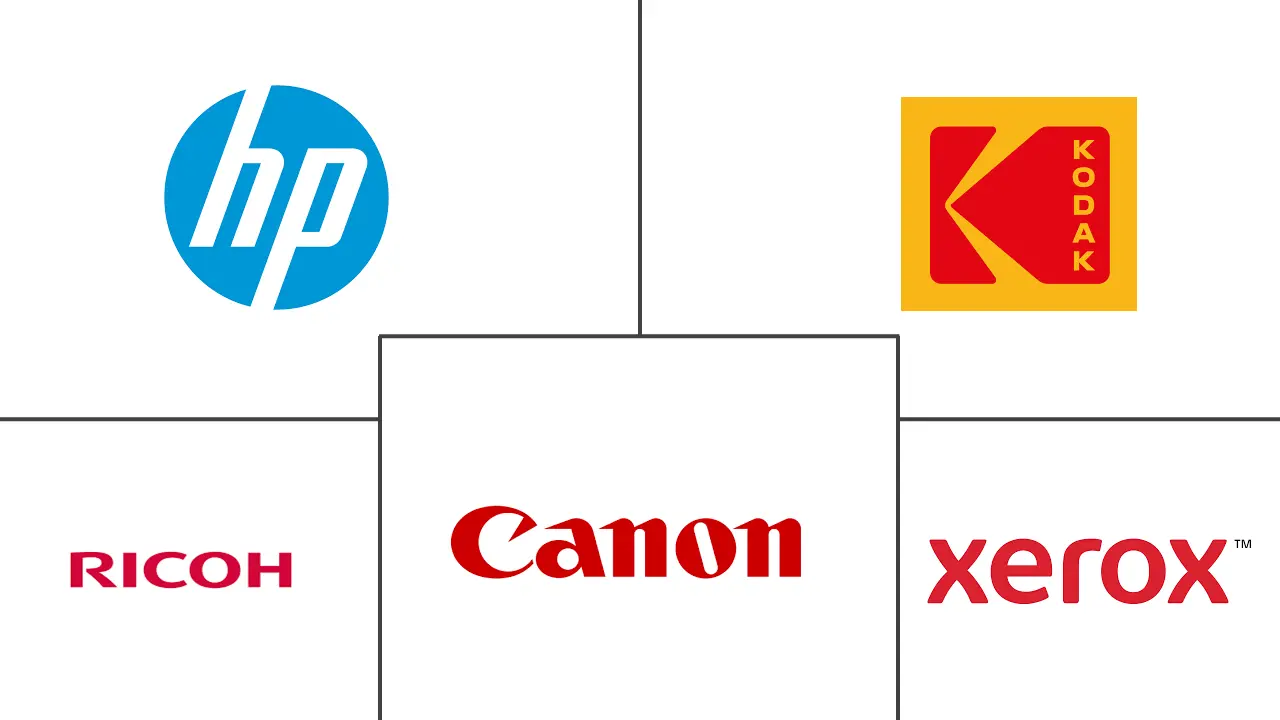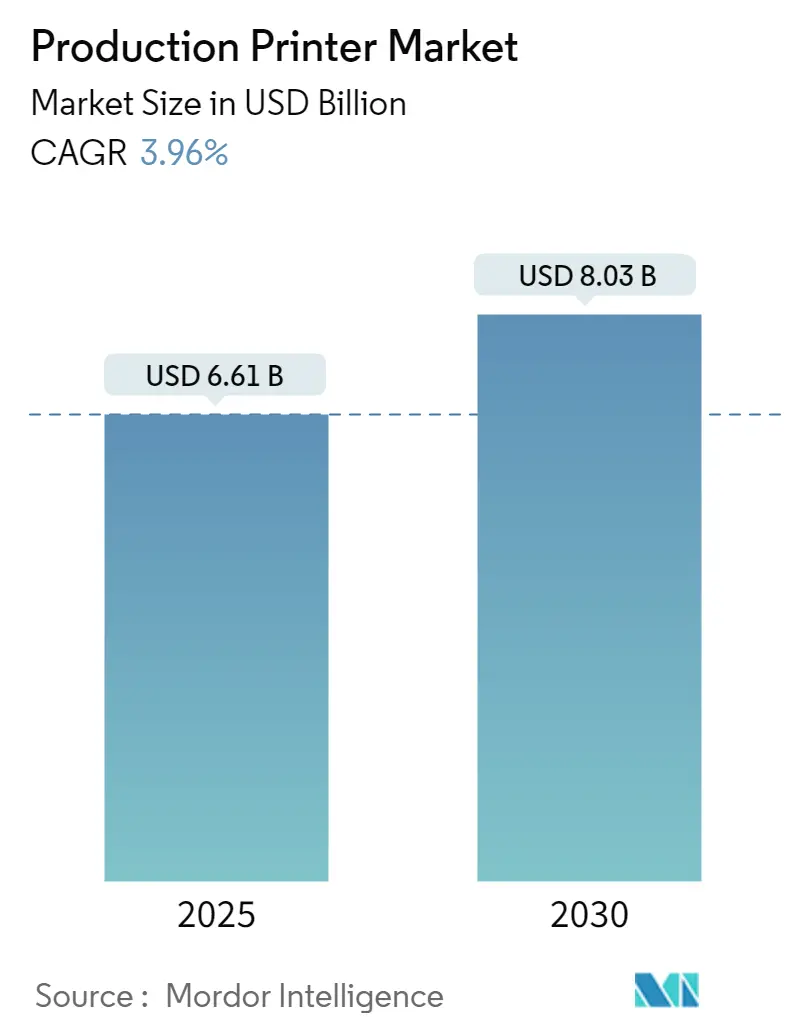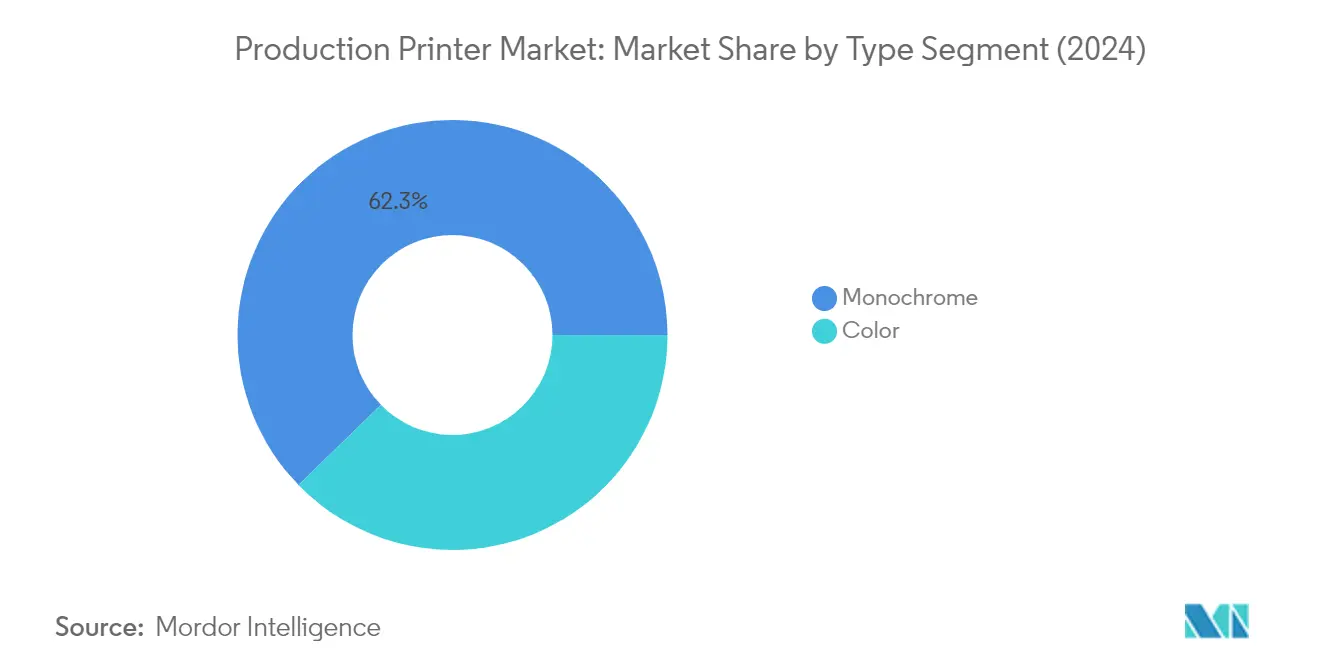Production Printer Market Analysis
The Production Printer Market size is worth USD 6.61 Billion in 2025, growing at an 3.96% CAGR and is forecast to hit USD 8.03 Billion by 2030.
The production printer industry is experiencing significant transformation driven by technological advancements and changing consumer preferences. Leading manufacturers are actively introducing innovative solutions to meet evolving market demands, as evidenced by several major product launches in 2023. For instance, in September 2023, Fujifilm launched the Revoria Press EC1100 and Revoria SC170/180, while Canon introduced the ProStream 3000 series in February 2023. These developments reflect the industry's focus on improving print quality, speed, and cost-efficiency while addressing sustainability concerns.
The packaging sector has emerged as a crucial growth catalyst, particularly in response to evolving retail and e-commerce dynamics. The tobacco products market alone is expected to generate revenue exceeding USD 1 trillion by 2027, driving demand for specialized packaging printing solutions. Quick Response (QR) codes have become mainstream in product packaging, enabling smartphone scanning for additional product information and promotional content, while folding cartons have become the predominant packaging material in the food industry due to innovations in design and digital printing capabilities.
Sustainability has become a cornerstone of industry development, with manufacturers increasingly focusing on eco-friendly solutions. According to a 2023 Aquapak study, 62% of companies surveyed plan to increase their budgets for sustainable packaging materials over the next five years. This shift is driving innovations in ink formulation, substrate development, and printing processes, with vendors like HP and Canon introducing energy-efficient models and eco-friendly consumables.
The publishing sector continues to demonstrate resilience despite digital transformation, with print media maintaining its relevance in specific segments. In the United States, consumer expenditure on recreational books reached USD 25.92 billion in 2022, while India witnessed growth in registered newspapers and periodicals from 118,239 in 2018 to 146,045 in 2022. This sustained demand, coupled with the need for high-quality commercial printing solutions, continues to drive innovation in production printing technology, particularly in areas requiring premium print quality and efficient production capabilities.
Production Printer Market Trends
Growth of Printing Applications in Packaging is Expected to Drive Growth
Packaging applications have emerged as the primary demand generator for production printers as digital package printing becomes increasingly mainstream. Product manufacturers are progressively targeting specific consumer groups through customized cardboard boxes and labels, reflecting a fundamental shift in packaging strategy. The evolution of e-commerce is creating unprecedented demands for printing methods that can match the industry's requirements for speed, volume, and standardization, while maintaining high quality and consistency.
The packaging industry's growth is further amplified by technological innovation and intense brand competition. Modern marketing strategies frequently involve limited-time promotions, seasonal packaging, and niche product launches, driving demand for production printers suitable for short-run printing jobs. These printers eliminate the need for expensive setups while offering quick turnaround times. Additionally, the increasing demand for innovative packaging from end-user segments like food, beverages, cosmetics, and others is creating new opportunities for production printer applications, particularly in areas requiring high-quality, customized printing solutions.
Increasing Inkjet Sales Due to Introduction of High-Performance Inkjet Printers
The inkjet printer segment is experiencing significant growth driven by technological advancements and improved performance capabilities. These printers offer numerous benefits, including high-speed printing, versatility in printing on various materials, and the ability to operate for extended periods with minimal servicing requirements. These advantages have made inkjet printers particularly attractive to businesses across multiple industries, including aerospace, food and beverage, packaging, and others.
The market is witnessing continuous innovation in inkjet technology, with new introductions of both continuous-feed and cut-sheet inkjet presses demonstrating up to 30% higher productivity than previous generations while supporting a broader range of substrates. For instance, in February 2023, Canon introduced the ProStream 3000 series, offering consistent offset print quality at industrial speeds on various substrates, including heavyweight paper. This advancement enables ultra-fast digital production across a broader range of commercial print jobs, from direct mail and book production to postcards, posters, and calendar printing, allowing customers to maximize the productivity benefits of inkjet production.
Segment Analysis: By Type
Monochrome Segment in Production Printer Market
The monochrome segment continues to dominate the production printer market, commanding approximately 62% market share in 2024. This significant market position is primarily driven by the segment's cost-effectiveness in terms of consumables and maintenance compared to color printers, making them a preferred choice for businesses looking to optimize printing costs. Monochrome printers are particularly favored in professional environments due to their fast printing speeds, low cost per print usage, and superior text quality, especially in monochrome laser printers. These printers remain integral to many critical applications, including books, user manuals, transactional printing, direct mail, reports, and forms. In the publishing industry, book printing and log printing operations predominantly adopt cut-sheet black-and-white or roll-to-sheet fed devices for book blocks or inside pages. The segment's dominance is further reinforced by its lower energy consumption and resource utilization compared to color printing, appealing to businesses aiming to reduce their environmental footprint.
Color Segment in Production Printer Market
The color segment in the production printer market is projected to experience the highest growth rate of approximately 5% during the forecast period 2024-2029. This accelerated growth is driven by the increasing demand for high-quality marketing collateral, packaging applications, and promotional materials where color printing plays a crucial role in brand visibility and consumer engagement. Color printers are becoming increasingly sophisticated with multiple colored ink cartridges, such as cyan and magenta, enabling businesses to create visually appealing brochures, catalogs, and flyers. The segment's growth is further propelled by technological advancements in color management and print quality, with vendors developing new technologies to reduce the traditionally higher costs associated with color printing. The rising adoption of digital printing technology, particularly in sectors like textile and garment manufacturing, is also contributing to the segment's expansion, as businesses increasingly recognize the value of color printing in creating differentiated and customized products.
Segment Analysis: By Production Method
Continuous Feed Segment in Production Printer Market
The continuous feed segment dominates the production printer market, commanding approximately 95% of the total market share in 2024. Continuous feed printers utilize rolls of paper, also known as web, making them ideal for high-capacity print runs that require additional processing through high-speed printers. These printers excel in handling bulky runs on uncoated stocks such as direct mail, business forms, documents, and transactional mail. The technology's superiority is evident in its conversion rate of substrates, with continuous inkjet printers operating at nearly three times the speed of thermal inkjet printers - approximately 300 meters of paper per minute compared to 100 meters. This exceptional speed capability makes continuous feed printing machines particularly suitable for high-output processes such as labels for industrial bottling and canning facilities, though actual speeds can vary based on the number of print codes required per meter of paper roll on the production line.
Cut Fed Segment in Production Printer Market
The cut fed segment is emerging as the fastest-growing segment in the production printer market, projected to grow at approximately 8% during 2024-2029. Cut sheet production printers, also known as cut sheet printers, utilize pre-cut sheets that are already sized before printing, typically in standard measures such as A4 and A3. These printers are gaining significant traction due to their ability to produce specialized-looking documents with high-quality, sharp colors, crisp text, and precise details. The resolution capabilities of these devices start at 600 DPI, with many sheet-fed printers possessing ultra-high DPI competence ranging from 600 to 1200 DPI, and some even reaching extreme high-resolution capabilities of 2400 to 4800 DPI. This growth is further fueled by their cost-efficiency in handling both single-page runs and large-scale operations of up to 1.75 million pages monthly, making them increasingly attractive for smaller print shops and large-scale companies with in-house printing requirements.
Segment Analysis: By Technology
Inkjet Segment in Production Printer Market
The inkjet segment dominates the production printer market, commanding approximately 87% market share in 2024, driven by its versatility and superior capabilities across various applications. Inkjet technology has established itself as the preferred choice due to its ability to generate short runs and products effectively while maintaining high-quality output. The technology's capacity to produce small runs and one-off products has enhanced its position as a key enabler in the printing ecosystem. Major players including Xerox, Canon, Ricoh, HP, and Lexmark have made substantial investments in inkjet technology, fostering improved quality, reliability, and productivity of inkjet equipment. The technology's prominence in the market is further reinforced by its ability to support increased online ordering and specification through web-to-print technology, which has become increasingly important for commercial printing operations.
Toner Segment in Production Printer Market
The toner segment is experiencing robust growth in the production printer market, projected to grow at approximately 5% during the forecast period 2024-2029. This growth is primarily driven by the increasing demand for high-quality commercial printing solutions and the technology's superior precision capabilities. Toner-based printing offers several key advantages, including better print speeds on average, more excellent precision prints, and cost-effectiveness for high-volume print users. The segment is witnessing significant technological advancements, with manufacturers focusing on developing eco-friendly and sustainable solutions, such as toners made from recycled materials or with lower carbon footprints. The technology's reliability and consistent print quality make it particularly attractive for businesses requiring high-volume printing capabilities, especially in commercial and office environments where print quality and speed are crucial factors.
Segment Analysis: By Application
Packaging Segment in Production Printer Market
The packaging segment dominates the production printer market, commanding approximately 44% market share in 2024. Packaging applications generate substantial demand for production printers as digital package printing has become mainstream in the industry. Product manufacturers are increasingly addressing focused groups of buyers through customized cardboard boxes and labels. The growth of e-commerce is driving the demand for better packaging solutions worldwide, compelling manufacturers to invest in high-quality printing solutions that can match the speed, volume, and standardization requirements of modern commerce. Technological innovation, combined with innovative packaging designs driven by intense competition and brand awareness, continues to increase the need for production printers. The market is also experiencing growth due to increasing demand for innovative packaging from end-user segments like food, beverages, cosmetics, and others. With the rising emphasis on sustainability and eco-friendly processes, packaging producers are increasingly adopting digital printing technologies that offer reduced waste and greater flexibility in production runs.
Commercial Segment in Production Printer Market
The commercial segment represents a significant portion of the production printer market, encompassing applications such as large format printing, marketing collaterals, and various business materials. Despite the digital age, print marketing collaterals continue to play a crucial role in promoting products and services, as quality printed marketing materials help attract customers and elevate brand presence. Digital printing has advanced to where businesses can achieve vibrancy and quality while accommodating materials like foils or transparent substrates. The variable data printing capability assists in personalizing direct mailers, postcards, brochures, and other marketing collaterals. High quality, cost-effectiveness, and ease of transport and handling make soft signage increasingly popular among customers. The segment's growth is further supported by the rising demand for advertising in retail, malls, and e-commerce sectors, providing a promising future for production printing in commercial applications.
Remaining Segments in Production Printer Market by Application
The publishing segment continues to maintain its significance in the production printer market, primarily driven by the persistent demand for printed books, magazines, and other publications. When it comes to book manufacturing, inkjet technology has proven particularly effective across a broad range of applications. The segment benefits from the growing trend toward shorter print runs and on-demand printing, which allows publishers to better match supply with demand and reduce inventory costs. Digital printing technology in publishing offers several advantages, including the ability to produce shorter runs economically, reduce waste, and provide quick turnaround times. The segment also caters to the educational sector, producing textbooks, workbooks, and other educational materials that continue to require high-quality print production.
Production Printer Market Geography Segment Analysis
Production Printer Market in North America
North America represents a mature printer market for production printers, driven by widespread adoption across commercial printing, packaging, and publishing sectors. The United States and Canada form the key markets in this region, with both countries showing a strong focus on technological advancement and automation in printing processes. The region benefits from the presence of major market players like Xerox and HP, along with robust infrastructure for digital transformation in the printing industry. The demand is particularly strong in the commercial printer sector due to growing requirements for marketing collaterals, business documents, and promotional materials.
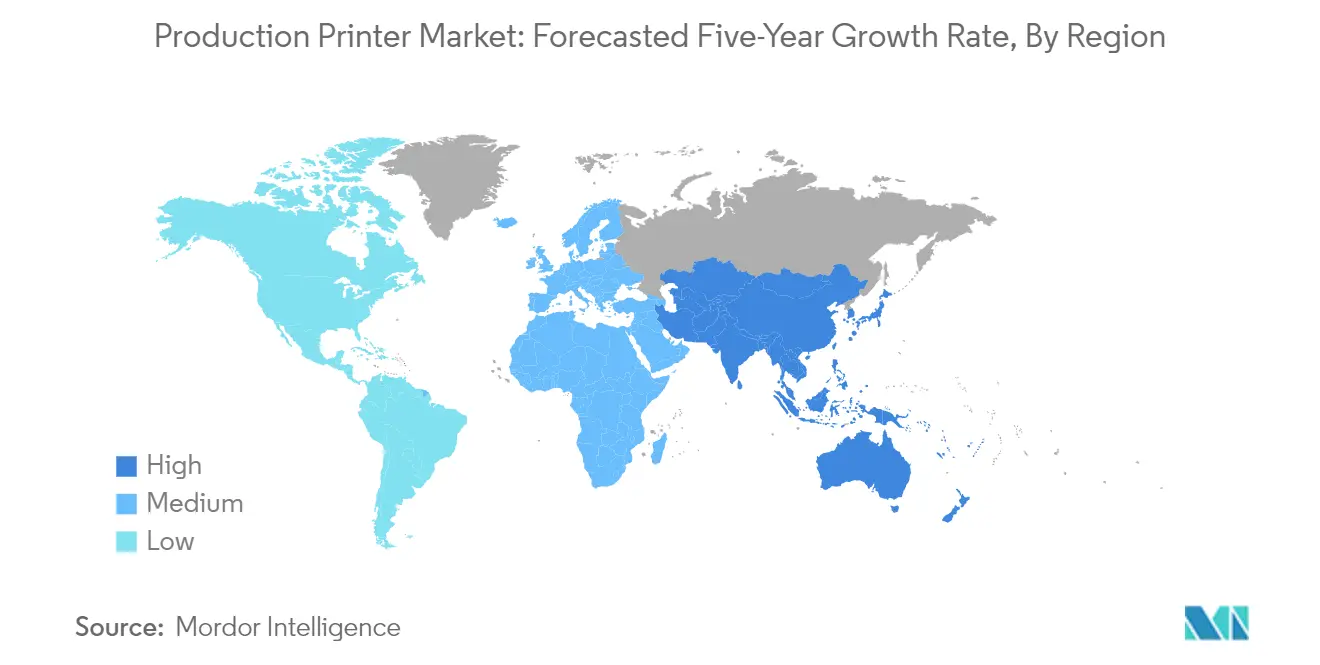
Production Printer Market in the United States
The United States dominates the North American production printer market, accounting for approximately 88% of the regional market in 2024. The country's market is characterized by wide-scale applications across government, enterprises, educational institutes, and commercial sectors. Favorable policies and initiatives from leading commercial printing associations such as PRINTING United Alliance and the National Association of Printing Ink Manufacturers (NAPIM) continue to boost market growth. The demand is particularly driven by the packaging industry's need for customization, safety assurance, and transparency in printing solutions. The presence of major market players and their continuous focus on innovation in areas like color management and variable data printing further strengthens the market position.
Production Printer Market in Canada
Canada emerges as the fastest-growing market in North America, with a projected growth rate of approximately 5% during 2024-2029. The country shows high adoption rates for advanced printing technologies across various industries. Market players are enhancing their focus on developing intelligent workplace service offerings to help customers accelerate their digital transformation. These services target diverse clients from global enterprises to governmental entities and small/medium businesses. The growing e-commerce sector, robust food and beverage industry, and increasing foreign investments in commercial ventures are driving market expansion. Canadian businesses are particularly focused on sustainability and eco-friendly printing practices, which is creating new opportunities for innovative printing solutions.
Production Printer Market in Europe
Europe represents a significant production printer market, characterized by strong technological adoption and innovation across various countries including Germany, the United Kingdom, France, and Italy. The region demonstrates particular strength in sustainable printing practices and digital transformation initiatives. The market is driven by growing demand from commercial printing, packaging, and publishing sectors, with each country showing distinct preferences and adoption patterns based on their industrial focus and technological readiness.
Production Printer Market in Germany
Germany leads the European market, holding approximately 27% of the regional market share in 2024. The country maintains its position as a significant global printing industry market due to its economic stability, increasing production output, and growing demand for effective printing solutions. According to the United Nations Industrial Development Organization's Competitive Industrial Performance Index, Germany continues to hold the top position in the world's competitive manufacturing sector. The market shows particular strength in high-quality production printer solutions for printing large quantities of production materials and high-speed printing of color photographs and labels.
Production Printer Market in France
France emerges as the fastest-growing market in Europe, with a projected growth rate of approximately 6% during 2024-2029. The country's market is experiencing significant transformation, particularly in the publishing sector. The French book market has shown remarkable growth, with increasing demand for art books, children's books, comics, and practical books. The market demonstrates strong adoption of digital printing technology, especially for business and industrial printing needs. French businesses are increasingly focusing on high-quality printing solutions that can deliver superior results while maintaining efficiency and cost-effectiveness.
Production Printer Market in Asia-Pacific
The Asia-Pacific region represents a dynamic and rapidly evolving production printer market, encompassing diverse economies including China, India, and Japan. The region demonstrates strong growth potential driven by increasing industrialization, rising demand for packaging solutions, and growing adoption of digital printing technologies. Each country in the region shows unique market characteristics based on their industrial development stage and technological adoption rates.
Production Printer Market in China
China dominates the Asia-Pacific production printer market, leading both in market size and technological advancement. The country's position is strengthened by its developed manufacturing industry, continuous innovation, and strong government support. The Made in China 2025 initiative, emphasizing "Quality over Quantity," has been particularly influential in driving the adoption of advanced digital printing technologies. The market shows significant activity in various applications including packaging, commercial printing, and industrial printing.
Production Printer Market in India
India emerges as one of the fastest-growing markets in the Asia-Pacific region, driven by its rapidly expanding economy and rising demand for high-quality print materials. The country's market benefits from the government's "Make in India" initiative, which has attracted several international industrial printer manufacturers to establish local manufacturing facilities. The digital printing segment shows particular promise, especially in sectors like textile and garment printing, where demand for customization and quick turnaround times is high.
Production Printer Market in Rest of the World
The Rest of the World market, encompassing regions like the Middle East, Africa, and Latin America, shows varying levels of market maturity and adoption rates. Brazil and Mexico emerge as the largest markets in Latin America, while the United Arab Emirates leads in the Middle East. The region demonstrates growing potential driven by increasing investments in manufacturing, tourism, and infrastructure development. The market is particularly influenced by the rapid growth of e-commerce, robust food and beverage industries, and increasing foreign investments in different commercial and industrial ventures. South Africa shows the fastest growth potential among these markets, driven by increasing adoption of advanced printing technologies and a growing industrial base.
Production Printer Market Overview
Top Companies in Production Printer Market
The production printer market is characterized by intense innovation and strategic developments from key players like Xerox, HP, Canon, Ricoh, Konica Minolta, and Kodak. These printer manufacturers are focusing on developing advanced printing technologies, particularly in inkjet and digital printing solutions, to meet evolving customer demands across commercial, packaging, and industrial applications. The industry demonstrates strong operational agility through continuous product launches and upgrades, exemplified by new digital press series and enhanced automation features. Strategic moves predominantly revolve around expanding digital transformation capabilities, strengthening service offerings, and developing sustainable printing solutions. Market leaders are actively pursuing geographical expansion through both direct presence and strategic partnerships, while simultaneously investing in research and development to maintain technological leadership. The emphasis on workflow integration, color management solutions, and end-to-end printing solutions reflects the industry's commitment to comprehensive customer service.
Consolidated Market with Strong Global Players
The production printer market exhibits a highly consolidated structure dominated by established global conglomerates with deep technological expertise and extensive distribution networks. These major players leverage their comprehensive product portfolios, established brand reputation, and strong financial capabilities to maintain printer market share. The market demonstrates significant barriers to entry due to the high capital requirements, technological complexity, and the need for established service networks, which favors incumbent players. Merger and acquisition activities are primarily focused on expanding technological capabilities, particularly in digital printing and automation solutions, as well as strengthening regional presence in high-growth markets.
The competitive dynamics are shaped by the presence of both diversified technology companies and printing specialists, with global players maintaining dominant positions through their ability to offer integrated solutions and comprehensive support services. Market consolidation continues through strategic acquisitions, particularly targeting companies with complementary technologies or strong regional presence. The industry shows a clear trend toward vertical integration, with major players expanding their capabilities across the value chain, from component manufacturing to end-user services, while also investing in digital transformation and sustainability initiatives.
Innovation and Service Excellence Drive Success
For incumbent players to maintain and expand their printer market share, the focus must be on continuous innovation in digital printing technologies, development of sustainable printing solutions, and enhancement of service offerings. Companies need to invest in advanced automation capabilities, cloud integration, and workflow optimization solutions while building stronger relationships with end-users through comprehensive support services. The ability to offer customized solutions for specific industry verticals, combined with robust after-sales support and training programs, becomes crucial for maintaining competitive advantage. Additionally, developing eco-friendly printing solutions and implementing circular economy principles in product design and manufacturing processes will become increasingly important for market leadership.
Contenders in the market can gain ground by focusing on niche applications, developing specialized solutions for specific industry segments, and leveraging partnerships for technology and market access. The relatively low substitution risk in professional printing applications provides opportunities for new entrants with innovative solutions, particularly in digital printing and sustainable technologies. Regulatory requirements, especially regarding environmental sustainability and digital security, are becoming increasingly important factors in shaping competitive strategies. Success in the market increasingly depends on the ability to provide integrated solutions that address both traditional printing needs and emerging digital transformation requirements while maintaining cost-effectiveness and operational efficiency.
Production Printer Market Leaders
-
Xerox Corporation
-
Canon Inc.
-
Ricoh Company Ltd
-
Hewlett-Packard Development Company, L.P.
-
Eastman Kodak Company
- *Disclaimer: Major Players sorted in no particular order
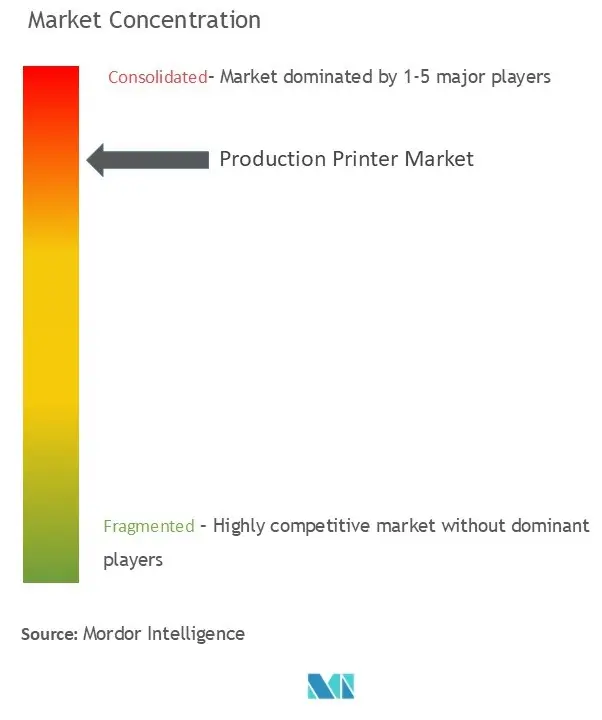
Production Printer Market News
- April 2024 - Konica Minolta Inc. and Fujifilm Business Innovation Corp. agreed to start a feasibility study for a strategic partnership in the areas of multifunction printers (MFPs), office printers, and production printers by signing a memorandum of understanding (MoU). FUJIFILM Business Innovation and Konica Minolta are evaluating the possibility of collaborating to enhance their business infrastructure, including setting up a reliable supply chain for their products.
- July 2023 - FUJIFILM Business Innovation Corp. launched two new production color press models—the Revoria Press EC1100 and Revoria Press SC180/SC170—offering superior productivity and image quality for professional and in-house printing needs.
Production Printer Market Report - Table of Contents
1. INTRODUCTION
- 1.1 Study Assumptions and Market Definition
- 1.2 Scope of the Study
2. RESEARCH METHODOLOGY
3. EXECUTIVE SUMMARY
4. MARKET INSIGHTS
- 4.1 Market Overview
- 4.2 Industry Stakeholder Analysis
-
4.3 Industry Attractiveness - Porter's Five Forces Analysis
- 4.3.1 Bargaining Power of Suppliers
- 4.3.2 Bargaining Power of Consumers
- 4.3.3 Threat of New Entrants
- 4.3.4 Threat of Substitutes
- 4.3.5 Intensity of Competitive Rivalry
5. MARKET DYNAMICS
-
5.1 Market Drivers
- 5.1.1 Growth of Printing Applications in Packaging is Expected to Drive Growth
- 5.1.2 Increasing Inkjet Sales Due to Introduction of High-performance Inkjet Printers
-
5.2 Market Restraints
- 5.2.1 Growth of Digital Marketing and the Practice of Online Reading
- 5.3 Impact of COVID-19 in Supply Chain Distribution of Production Printer Globally
6. KEY TECHNOLOGY INVESTMENTS
- 6.1 Cloud Technology
- 6.2 Artificial Intelligence
- 6.3 Cyber Security
- 6.4 Digital Services
7. MARKET SEGMENTATION
-
7.1 By Type
- 7.1.1 Monochrome
- 7.1.2 Color
-
7.2 By Production Method
- 7.2.1 Cut Fed
- 7.2.2 Continuous Feed
-
7.3 By Technology
- 7.3.1 Inkjet
- 7.3.2 Toner
-
7.4 By Application
- 7.4.1 Commercial
- 7.4.2 Publishing
- 7.4.3 Packaging
-
7.5 By Geography
- 7.5.1 North America
- 7.5.1.1 United States
- 7.5.1.2 Canada
- 7.5.2 Europe
- 7.5.2.1 Germany
- 7.5.2.2 United Kingdom
- 7.5.2.3 France
- 7.5.2.4 Italy
- 7.5.2.5 Rest of Europe
- 7.5.3 Asia-Pacific
- 7.5.3.1 India
- 7.5.3.2 China
- 7.5.3.3 Japan
- 7.5.3.4 Rest of Asia-Pacific
- 7.5.4 Rest of the World
8. COMPETITIVE LANDSCAPE
-
8.1 Company Profiles*
- 8.1.1 Xerox Corporation
- 8.1.2 Hewlett-Packard Development Company LP
- 8.1.3 Ricoh Company Ltd
- 8.1.4 Canon Inc.
- 8.1.5 Eastman Kodak Company
- 8.1.6 Konica Minolta Inc.
- 8.1.7 Miyakoshi Printing Machinery Co. Ltd
- 8.1.8 Inca Digital Printers Ltd (Dainippon Screen Mfg. Co. Ltd)
9. INVESTMENT ANALYSIS
10. MARKET OPPORTUNITIES AND FUTURE TRENDS
Production Printer Market Industry Segmentation
The production printer, also known as a production-level printing machine or high-speed output printer, is designed to produce large volumes for high-speed output. In commercial printing environments where documents, brochures, catalogs, flyers, and similar materials must be produced in large quantities, it is normally utilized by print companies, publishing establishments, or marketing agencies.
The production printer market is segmented by type (monochrome and color), production method (cut fed and continuous feed), technology (inkjet and toner), application (commercial, publishing, and packaging), and geography (North America (United States and Canada), Europe (Germany, United Kingdom, France, Italy, and rest of Europe), Asia-Pacific (India, China, Japan, and rest of Asia-Pacific), and rest of the World). The market sizes and forecasts are provided in terms of value (USD) for all the above segments.
| By Type | Monochrome | ||
| Color | |||
| By Production Method | Cut Fed | ||
| Continuous Feed | |||
| By Technology | Inkjet | ||
| Toner | |||
| By Application | Commercial | ||
| Publishing | |||
| Packaging | |||
| By Geography | North America | United States | |
| Canada | |||
| Europe | Germany | ||
| United Kingdom | |||
| France | |||
| Italy | |||
| Rest of Europe | |||
| Asia-Pacific | India | ||
| China | |||
| Japan | |||
| Rest of Asia-Pacific | |||
| Rest of the World | |||
Production Printer Market Research FAQs
How big is the Production Printer Market?
The Production Printer Market size is worth USD 6.61 billion in 2025, growing at an 3.96% CAGR and is forecast to hit USD 8.03 billion by 2030.
What is the current Production Printer Market size?
In 2025, the Production Printer Market size is expected to reach USD 6.61 billion.
Which is the fastest growing region in Production Printer Market?
Asia Pacific is estimated to grow at the highest CAGR over the forecast period (2025-2030).
Which region has the biggest share in Production Printer Market?
In 2025, the Asia Pacific accounts for the largest market share in Production Printer Market.
What years does this Production Printer Market cover, and what was the market size in 2024?
In 2024, the Production Printer Market size was estimated at USD 6.35 billion. The report covers the Production Printer Market historical market size for years: 2019, 2020, 2021, 2022, 2023 and 2024. The report also forecasts the Production Printer Market size for years: 2025, 2026, 2027, 2028, 2029 and 2030.
Our Best Selling Reports
Production Printer Market Research
Mordor Intelligence provides comprehensive insights into the production printer market through detailed industry analysis and market outlook. Our research covers various segments including commercial printers, industrial printers, label printers, and large format printers, offering stakeholders a deep understanding of market dynamics, competitive landscape, and growth opportunities. The report pdf includes extensive market data on variable data printing, managed print services, and emerging technological trends, helping businesses make informed decisions about their printing solutions and investments.
Our consulting expertise extends beyond traditional market research to provide strategic insights for the production printing industry. We assist stakeholders in evaluating new product launches, conducting technology scouting for advanced printing solutions, and analyzing customer needs and behavior patterns in both commercial and industrial printing segments. Our capabilities include comprehensive competition assessment, analysis of digital production printer innovations, and evaluation of market entry strategies. Through B2B surveys and data analytics, we help clients understand the evolving landscape of production print technologies, enabling them to optimize their market positioning and identify growth opportunities in the printer industry.

